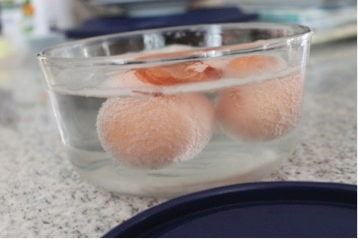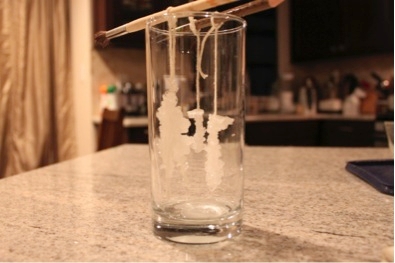Kitchen Chemistry
Get your safety goggles out and get ready for some science fun! Here are two great experiments to try at home with your kids. Adult supervision is of course recommended.

Naked Eggs

Supplies: eggs, vinegar
Put 2 or 3 eggs in a container and cover with vinegar. Tiny bubbles will form on the eggshells within the first few minutes. Cover the container and refrigerate for 24 hours. Using a big spoon, remove the eggs carefully and empty out the vinegar. Be careful! The eggshell may be almost completely dissolved, leaving only a thin membrane holding everything together. Replace the eggs in your container, and cover again with fresh vinegar. Cover and put it back in the refrigerator for another 24 hours. This time, remove the eggs and rinse them very carefully. If any of the naked eggs are leaking, then the membrane has broken and you should throw it out. Now you have eggs without shells! They look translucent and have interesting behaviors - try squeezing them very gently.
What happened? Vinegar is acetic acid, and it reacts with the eggshell, which is calcium carbonate.
Acetic acid breaks apart calcium carbonate, releasing calcium ions and carbonate ions. The bubbles you see forming on the eggshell are carbon dioxide gas (CO2), which is formed as the reaction creates carbonate ions (CO32).
Change it up! Try this experiment again using different kitchen acids, or different temperatures, or with hardboiled eggs to see what happens differently.
Rock Candy

Supplies: sugar, water, cotton string/twine, pencil, tall glass
This experiment requires an adult to help with the stove and the hot liquids.
Cut a piece of twine about 6-8 inches long, and tie it around the center of a pencil. Place the pencil horizontally across the top of a tall glass. The string should hang down into the center of the glass. Trim the sting to prevent it from touching the bottom of the glass. Optional - You can also attach a small weight like a screw to the bottom of the string to keep it from floating later. Take the pencil/string off the cup for now.
You will need 1 cup of water and about 4 cups of sugar. Place 1 cup water and ½ cup sugar in a pot. Optional – add a few drops of food coloring. Place the pot on the stove and turn on the heat. Heat the water-sugar mixture until it gets very hot, almost boiling. Add more sugar to the mixture, about ½ cup at a time, and stir until all of the sugar dissolves and the liquid is clear again. Keep adding sugar and stirring until the sugar will no longer dissolve. You will have a very hot, sticky, thick sugar-water mixture.
Now CAREFULLY pour the sugary syrup into the tall glass. Place the pencil on top, and let the string hang into the middle of the glass and into the sugar-water mixture. Keep the string as far from the walls of the glass as possible. Leave the glass sitting on a counter for 4-7 days. Check it each day to see how sugar crystals form on the string. When you are happy with the size of your rock candy, or when it has stopped growing, carefully remove the string from the cup.
What happened? Making rock candy is a great way to learn about the concept of saturation. At room temperature, only a certain amount of sugar can dissolve in water before the water becomes saturated. When you heat the water, a lot more sugar can dissolve into it before the solution hits its saturation point. When the hot saturated solution cools off, it becomes supersaturated, meaning there is more sugar dissolved in the water than it can hold. Some of the sugar crystallizes out of the solution onto the string, forming your rock candy! Sugar will crystallize out of the solution until it is no longer supersaturated, and is only saturated.
Michal Melamede is the owner of scienceSeeds, a science enrichment program that seeks to engage children and their parents in discovering the mysteries of the world we live in. They offer after-school classes, camps and science-themed parties in an inviting, nurturing, family-friendly environment. For more information visit www.scienceseeds.com or call 917.453.1451.







